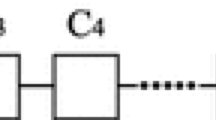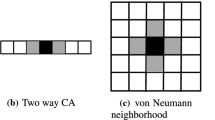Abstract
A model of cellular automata (\({\mathrm {CA}}\)) is considered to be a well-studied non-linear model of complex systems in which an infinite one-dimensional array of finite state machines (cells) updates itself in a synchronous manner according to a uniform local rule. A sequence generation problem on the \({\mathrm {CA}}\)s was studied and many scholars proposed real-time sequence generation algorithms for a variety of non-regular sequences such as \(\{2^n \,|\,n = 1, 2, 3,\ldots \}\), prime, and Fibonacci sequences. In this paper, we show that sequence \(\{ k^n | n=1, 2, 3, \ldots \}\) can be generated in real-time by a k-state \({\mathrm {CA}}\), when \(k \ge 3\), and give a mathematical proof of the correctness of the implementation.






Similar content being viewed by others
Explore related subjects
Discover the latest articles and news from researchers in related subjects, suggested using machine learning.References
Arisawa M (1971) On the generation of integer series by the one-dimensional iterative arrays of finite state machines. Trans IECE 54–C(8):759–766 (in Japanese)
Fischer PC (1965) Generation of primes by a one-dimensional real-time iterative array. J. ACM 12(3):388–394
Kamikawa N, Umeo H (2008) Some state-efficient algorithms for real-time generation of non-regular sequences on cellular automata. In: Proceedings of the 13th International symposium on artificial life and robotics, pp 47–50
Kamikawa N, Umeo H (2009) A design of algorithms for real-time generation of linear-recursive sequences on cellular automata. In: Proceedings of the 14th international symposium on artificial life and robotics, pp. 281–286 (2009)
Kamikawa N, Umeo H (2012) A study on sequence generation powers of small cellular automata. SICE J Control Measur Syst Integr 5(4):191–199. https://doi.org/10.9746/jcmsi.5.191
Kamikawa N, Umeo H (2016) A construction of five-state real-time Fibonacci sequence generator. Artif Life Robot 21(4):531–539. https://doi.org/10.1007/s10015-016-0309-2
Kamikawa N, Umeo H (2018) Realization of exponential sequence generation by one-dimensional finite-state cellular automata. In: IPSJ SIG technical reports on mathematical modeling and problem solving, 2018-MPS-117(15), pp 1–6 (in Japanese)
Kamikawa N, Umeo H (2019) A simple and smaller-state implementation of generation algorithm for exponential sequences on cellular automata. In: Proceedings of the 24th international symposium on artificial life and robotics, pp 150–155
Korec I (1998) Real-time generation of primes by a one-dimensional cellular automaton with 9 states. In: Proceedings of the 2nd international colloquium on universal machines and computations, pp 101–116
von Neumann J (1968) Theory of self-reproducing automata. In: Burks AW (ed) University of Illinois Press, Illinois
Author information
Authors and Affiliations
Corresponding author
Additional information
Publisher's Note
Springer Nature remains neutral with regard to jurisdictional claims in published maps and institutional affiliations.
This work was presented in part at the 24th International Symposium on Artificial Life and Robotics, Beppu, Oita, January 23–25, 2019.
About this article
Cite this article
Kamikawa, N., Umeo, H. A construction of simple and smaller-state real-time generator for exponential sequences. Artif Life Robotics 25, 64–72 (2020). https://doi.org/10.1007/s10015-019-00569-3
Received:
Accepted:
Published:
Issue Date:
DOI: https://doi.org/10.1007/s10015-019-00569-3




